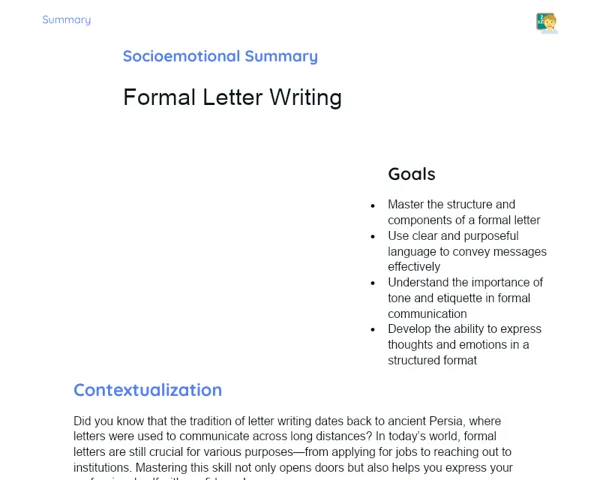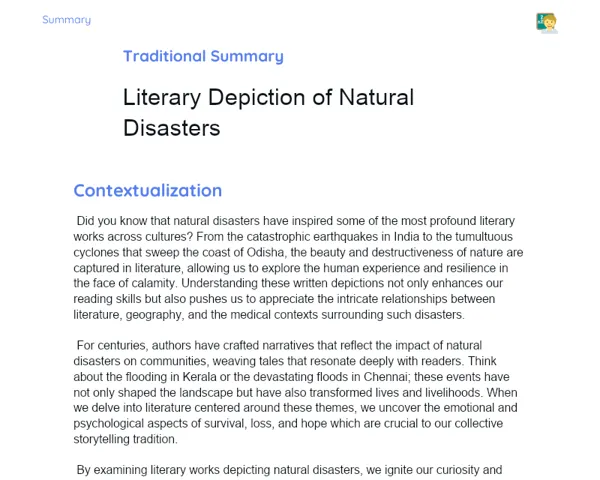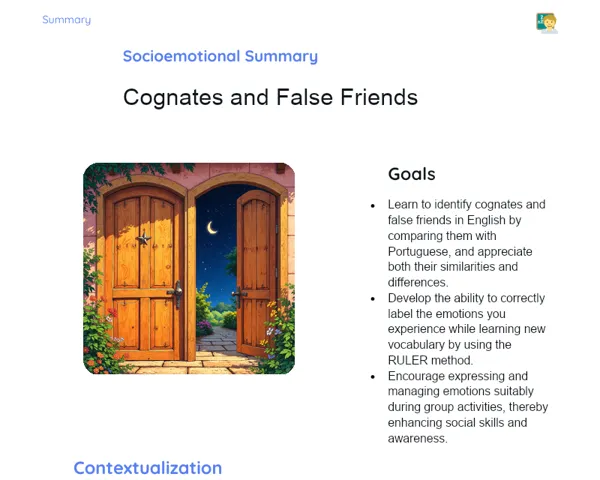Stories that Connect: Bridging Lessons with Life!
Goals
1. Learn to connect personal experiences with new ideas from our study material.
2. Develop the ability to reflect on your emotions and understand how they relate to different situations.
3. Enhance your communication skills by sharing these connections in discussions.
Contextualization
Did you know that storytelling is a powerful tool used for centuries in Indian culture? From the famous tales of the Mahabharata to the everyday stories we hear from our grandparents, these narratives help us connect our personal experiences with broader life lessons. In our class today, we'll explore how sharing our own stories can shine a light on the ideas we learn in English, making them more relatable and impactful!
Exercising Your Knowledge
The Power of Personal Storytelling
Storytelling is not just a way to share experiences; it's a bridge that connects our inner lives with the outside world. In our Indian culture, stories have always played a pivotal role, whether it's your grandmother recounting her village tales or the epic stories from our literature. These narratives allow us to express our feelings and thoughts, making connections between our personal experiences and the broader lessons we learn. By sharing these stories in class, you can show how your own journey enriches the ideas we explore in English, making learning a shared and engaging experience.
-
Sharing helps us connect: When we share experiences, it helps others understand how similar situations can evoke different emotions, fostering empathy.
-
Encourages self-reflection: Telling a story makes us think deeply about our own feelings and the lessons we've learned, enhancing our emotional intelligence.
-
Builds communication skills: Articulating our stories improves our ability to express ourselves clearly and confidently, which is crucial in any language.
Emotional Connections
Each story we tell is laden with emotions—joy, sadness, anger, and love. These emotions are universal, yet deeply personal. By acknowledging our feelings during storytelling, we learn to validate not just our own emotions but also those of others. This component emphasizes identifying emotions in our experiences, allowing us to articulate and relate them to class concepts. Understanding these connections nurtures emotional literacy, an essential skill for both personal growth and social interactions.
-
Emotions drive understanding: Recognizing emotions helps us grasp the nuances in stories and learn how different perspectives shape our views.
-
Fosters compassion: By sharing and listening to emotional experiences, we cultivate a sense of community and support among peers.
-
Enhances resilience: Exploring emotions through stories helps us understand that it's okay to feel vulnerable, teaching us how to cope and bounce back from challenges.
Connecting Class Concepts to Everyday Life
Incorporating personal experiences into our academic discussions makes learning relatable and practical. When you connect what you learn in class to real-life situations, you anchor that knowledge in your own reality. This not only enhances retention but also sparks curiosity and critical thinking. For instance, learning about themes of friendship in stories can lead to meaningful discussions about your own friendships and how they shape your life.
-
Relevance to real life: Making connections between lessons and your personal life shows that education is not just about facts but about understanding the world.
-
Encourages creative thinking: Relating concepts to personal experiences induces creativity, allowing you to think outside the box and apply lessons in various contexts.
-
Builds critical thinking: Asking yourself how your experiences relate to classroom discussions challenges you to think critically and explore deeper meanings.
Key Terms
-
Storytelling: The art of sharing stories that connect personal experiences with broader themes and lessons.
-
Emotional intelligence: The ability to recognize, understand, and manage our own emotions as well as those of others.
-
Connection: The act of linking new ideas and concepts to personal experiences to enhance understanding and relatability.
For Reflection
-
Think of a moment when you shared a personal experience in class. How did it feel to connect your story with what we were learning? Reflect on the emotions it stirred within you.
-
Consider a story you've heard from someone else. What personal experiences did it remind you of? How can those connections enhance our collective learning?
-
Why do you think storytelling is so important in our culture? Reflect on how it shapes our understanding of the world and our relationships with others.
Important Conclusions
-
Today, we discovered the immense power of storytelling in making connections between our personal experiences and the ideas we learn in English.
-
We learned that by sharing our stories, we enhance our emotional intelligence, foster empathy, and improve our communication skills.
-
Connecting class concepts to our everyday life not only makes learning relevant but also sparks curiosity and critical thinking.
Impacts on Society
In our fast-paced world, storytelling remains one of the essential ways to build community and empathy. When we share our personal experiences, we create bonds that transcend differences and foster understanding. For instance, think about how sharing moments of joy or struggle can encourage friends or classmates to open up to each other—this nurtures a supportive environment where everyone feels valued. As students, you face various social situations daily—whether navigating friendships or addressing conflicts. Personal storytelling allows you to relate to one another on a deeper level, highlighting that we all share similar emotions and experiences, even if our backgrounds differ. This is especially important in our diverse society, where the ability to empathize can lead to stronger connections and less conflict.
Moreover, storytelling has the power to challenge norms and reshape perspectives. By sharing your stories, you contribute to the broader narrative of society—one that can inspire change and foster a more inclusive community. Imagine discussing your thoughts during a class debate or reflecting on a personal experience during a group project; your unique voice adds richness to our collective learning. In the grand tapestry of life, your stories are the threads that connect us all, reinforcing the importance of understanding each other in a world that sometimes feels fragmented.
Dealing with Emotions
To help you navigate your emotions while connecting personal experiences to class concepts, I challenge you to engage in the RULER method at home! Begin by recognizing an emotional experience from your day—perhaps a moment of excitement when you scored a goal in cricket or a feeling of disappointment when a friend let you down. Next, take a moment to understand the causes of that emotion: What triggered it? How did it affect your behavior? Once you identify your emotion, label it accurately—using words like "happy," "sad," "frustrated," or "elated." Now, express this emotion through art! Draw or write about the experience, articulating not only the event but also how it connected to something you learned in class. Finally, think about how you can regulate this emotion—what can you do to maintain a positive mindset moving forward? This exercise will deepen your emotional understanding while enriching your learning journey.
Study Tips
-
Keep a journal: Regularly write down personal experiences and feelings that relate to what you're learning in class; this enhances retention and self-reflection.
-
Discuss with family: Share stories from your day with your parents or siblings, and ask them to share theirs. This will strengthen your narrative skills and emotional vocabulary.
-
Create a storytelling circle: Gather friends virtually or in your locality and take turns sharing stories, focusing on connecting them with lessons from school. This promotes active listening and empathy!



